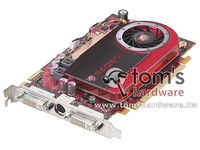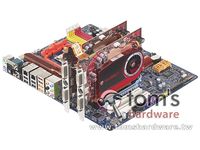AMD to Strike Nvidia 9500 With HD4600
The graphics card market has been quite intense lately up until now. With the clouds and dust settling after the AMD and Nvidia dispute, both contenders are playing on an even battle field – Or are they?
Coming this September 10, AMD plans to unveil its HD4600 series (RV730 XT / PRO) cards to directly compete with the Nvidia 9500 series. We will see two flavors brought forward as the HD4670 (RV730-XT) and the HD4650 (RV730-Pro). Both cards are manufactured on the 55 nm architecture at speeds of 750 MHz and 600 MHz. Each card will utilize 320 Stream Processing Units.Some of the other technical, and notable features of the HD4600 series are as follows:
- PowerPlay 2.0 Functions
- Unified Video Decoder 2 (UVD 2
- Direct-X 10.1
- Shader Model 4.1
- Physics acceleration & Dynamic geometry acceleration
- 24X CFAA Technology

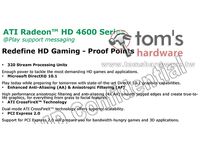

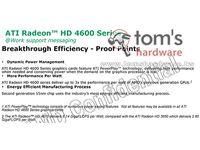
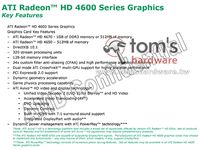
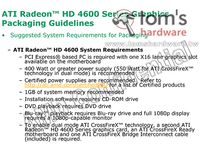
Another point worth mentioning is that new V3700 & V5700 FirePro specialized workstation cards are based off the RV730-XT (HD4670) technology. Both card editions will also have Macro Vision Detection (MVD) on them as well. Macro Vision Detection is a form a copy protection that is transparent while viewing media, but apparent when attempting to copy certain media from input sources. Typically the copied version has the quality substantially degraded.
| Kit | Model | Freq. | Memory | Bandwidth | Pattern | HDCP | CrossFire |
| B70901 | RV730 XT | 750/1000 | 512 MB GDDR3 | 128-bit | 16Mx32 dual rank | Yes | Hardware |
| B66601 | RV730 XT | 750/873 | 1 GB DDR3 | 128-bit | 64Mx16 | Yes | Hardware |
| B66801 | RV730 PRO | 600/500 | 512 MB DDR2 | 128-bit | 32Mx16 | Yes | Software |
| B66501 | RV730 PRO | 600/500 | 512 MB DDR2 | 128-bit | 32Mx16 | Yes | Software |
| N/A* | RV730 PRO | 600/667 | 512 MB DDR3 | 128-bit | 32Mx16 | Yes | Hardware |
Both the HD4670 and HD4650 utilize a 128-Bit memory bandwidth. No 256-Bit version has been mentioned as of current. The HD4650 coming with 512MB DDR2 and the HD4670 coming with a choice of 512 MB or 1024 MB DDR3. The HD4670 (RV730-XT) supports hardware crossfire while the HD4650 (RV730-Pro) supports software based crossfire at this time. It appears that there is a version utilizing the RV730-Pro technology that will support hardware crossfire, however at this time it is not set it in stone.
Power consumptions of the HD4600 series are relatively low at 70 to 80 Watts for the HD4670 and 50 to 55 Watts for the HD4650. It’s also worth mentioning the lack of external power connector on this series of card, which has its pros and its cons. Average systems housing 450 Watts or more should be just fine with this card. If you plan to run two cards in crossfire 550 Watts minimum is suggested.
Based on this information however, the 4600 series being a new release appears to be somewhat of a step backward. If you were to compare the specs of the HD4670 (RV730) to the older HD3870 (RV670) you would instantly notice the dial has been turned back on the specs, and what for? Let’s have a look:
Get Tom's Hardware's best news and in-depth reviews, straight to your inbox.
| HD3870 (RV67) | HD4670 (RV730) | |
| Engine | 775 MHz | 750 MHz |
| Memory | 1125 MHz | 1000 MHz |
| Interface | 256-Bit | 128-Bit |
| Stream Processors | 320 | 320 |
| Architecture | 55n m | 55 nm |
| Transfer | 72 GB/s | 32 GB/s |
| TDP | 90 – 100 Watts | 70 – 80 Watts |
As you can clearly see, the HD4670 (RV730) appears to be a dialed back version of the older HD3870 (RV670). Seeing as the HD3870 is still readily available all over the web and in stores for a reasonable average price of $130 and the HD4870 for $270 – there may be little incentive to purchase this card. (Unless if the HD3800 series were completely phased out and not so readily available, the HD4600 series could take its place with a new price.) A real benefit to this card is quite possibly for a Home Theatre PC in a compact case stuffed into a ventilation restricted entertainment unit. Since the HD4600 series cards have lower wattage. With the lack of an external power connector, they certainly will not be generating much heat turning your case into an easy-bake oven.
-
cal8949 i think it would be smart for ati to make the ultimate htpc video card with composite video, hdmi, video s, dvi and keep it around 60-80. that would be a good way to win that marketReply -
kitsilencer This is where the money is: mid-range cards for the masses. Judging from initial specs, though, it feels like a bit of a letdown. We'll see though.Reply -
wolfie2xThose double underlined snaplink bubbles are the ugliest things on earth. Why can't they just make it a little less intrusive and less ugly? dah..but there's an easy way to turn it off.. just goto the faq page on snap.com and there's a link to disable it. no more ugly double lines direct link: http://www.snap.com/about/linkbubb kbubbles=1Reply
where are they, dude? I don't see them. -
goonting great...goot for a low power build...i wonder if it can handle up 1440x900 resolution on most games with eye candy enabledReply -
smalltime0 cjlIt should - it seems like a slightly crippled 3870, which is hardly a bad card.I thought it looked more like a 3870, but using a little less power.Reply
But it should be pretty good. -
This is intended to be a mid-range card, and it looks to be a winner, this is light years beyond the previous generation mid-range cards. I don't see why people are comparing it to the previous generation high-end card. IMHO the 4850 is really not that expensive if you want the extra performance.Reply
-
Kari Joz320 stream proccesors ... twice as much as the older mid-range...doesn the 9500 series only have 32...the same as the old 8600...that's like comparing oranges to bowling balls...Reply -
Reply
Seeing as the HD3870 is still readily available all over the web and in stores for a reasonable average price of $130 – there may be little incentive to purchase this card.
You forget the price. The HD48-Series brings high-end graphics to mid-range prices. Therefore the new cards don't need to be able to run the higher resolutions. Therefore 128bit memory interface are enough. The new chip AND the narrow interface should make these cards really cheap. -
djfourmoney In older games it should be fine at higher resolutions actually. I have targeted this card since word first leaked out. I had a HD3870 for two days, it was Rev 3 meaning it had the Zero Thermal cooling solution which was much too large for my narrow mATX board, I had to remove a tuner card.Reply
However Aaron is wrong, I found that HD3870 from a link on Slickdeals.net It was from Micro Center here in Southern California. It was $119 before tax. I have NOT found one that is the original ATI reference board that I know will fit my motherboard for under $130. The HD3850 can be found for under $100, but this will eat it alive.
I could afford a HD4850 but I don't play games on a PC often enough to spend that kind of money for basically part time use and reduced use in 6-8 months down the road.
ATI also announced a few weeks back they are stopping production of the 3xxx series all together, so whatever is out there now is out there. I can't find another HD3870 for under $130 out the door, true single slot. Even so, turn on the filters and the FPS will drop, not so with the HD46xx cards and two HD4670 should beat a HD4850 and give a HD4870 a run for its money. Given the cost of the 9600GT at around $130, I would expect the HD4670 to come in around $10 less no rebate which would put the decision on the person buying, do I wait for the rebate on the Nvidia and pay $130 now or do I get the newest ATI "budget" card for $10 less no rebate involved and I assure you performance is close if not better than the 9600GT.
When we'll you guys get a test sample to put it through its paces and PLEASE test GRID with it. That's what I'm getting this card for...
